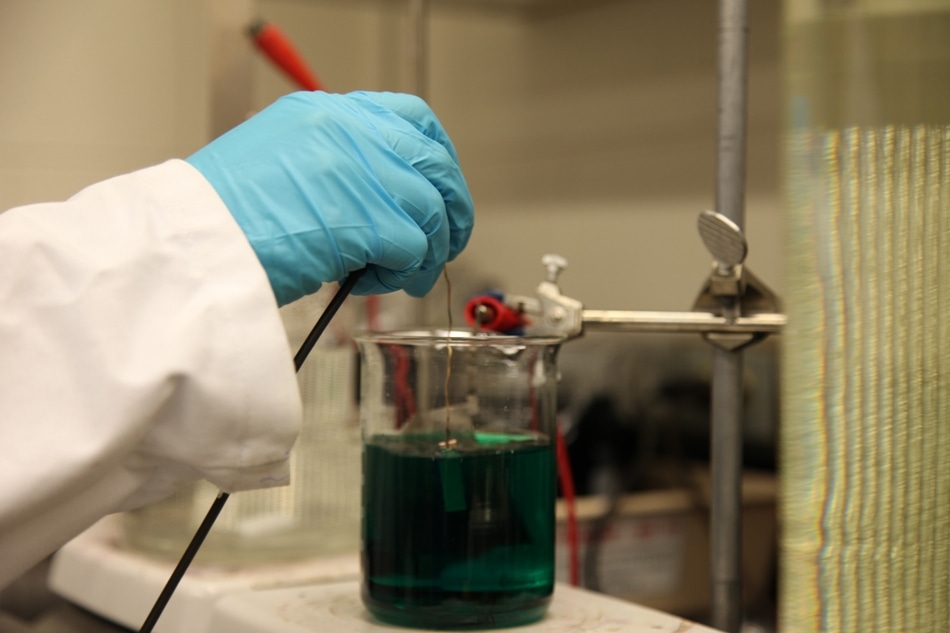May 2 2018
 The process of electroplating in the CIRES Intrument Lab. (Credit: Katie Weeman/CIRES)
The process of electroplating in the CIRES Intrument Lab. (Credit: Katie Weeman/CIRES)
In September 2017, Don David, a CIRES chemist and instrument designer, and his colleagues Dave Pappas and Xian Wu from the National Institute of Standards and Technology (NIST) discovered a robust new plated metal combination with the ability to superconduct at easily achievable temperatures, opening the door for the subsequent significant steps in the development of groundbreaking supercomputers.
David and his team have just reported the innovative technology: sandwiching an ultrathin layer of rhenium between layers of gold, where each gold layer measures 1/1000th the diameter of a strand of human hair and can superconduct at a critical temperature of more than 6 K.
The sheer magnitude of the critical temperature was unexpected. We had been thinking for a while about ways to impart superconducting properties to gold and copper films, and we were surprised at how robust and effective the thin layer of electroplated Re was.
Don David, Director, CIRES Integrated Instrument Development Facility
Superconductors are materials that have zero electrical resistance on being cooled to a critical temperature, which is, in general, remarkably low and expensive to acquire. The electroplated rhenium developed by the team satisfies ideal properties needed for use in circuit boards for next-generation, ultrafast computing applications: melts at high temperatures, non-toxic, mechanically easy to work with, and superconducting at higher, easier-to-obtain critical temperatures. The new discovery is already gaining attention from international computing giants.
Almost every day, David performs electroplating, which involves passing an electrical current through an aqueous solution of a dissolved metal to form a metal coating on a submerged object. David’s work is highly demanded in the research world: He and his colleagues support science by plating instruments such as components for cryogenic applications and charged-particle optics, and here, circuit boards for a group at NIST. They were in the search of a metal plating that could superconduct for the Pappas’s Quantum Processing Group at NIST. Earlier, the group had unsuccessfully tried several combinations. Then one fine day, Xian Wu, David’s NIST colleague, suggested them to try rhenium: a hard, trace metal that has a high melting point and is often used in the construction of jet engine turbines.
The researchers tested for electrical resistance and were contented to observe that it superconducted up to 6 K, well above the boiling temperature of liquid helium, which is 4.2 K. At present, they are testing the influence of strain, interfaces, and hydrogen incorporation on the improved superconducting temperature. However, whatever may be the reason for the improvement, the ability to electroplate a superconductor is a huge step toward the development of next-generation high-performance, superconducting computers.
Every computer includes a circuit board—a layered, electronic plank on which thousands of conductive pathways are etched. Electrical information in the form of pulses called “bits” speed their way across the board, performing the functions of the computer. In standard computers, the material with which the board is formed hinders these electrical pulses— the electrons speeding up about the circuitry are slowed down by electrical resistance, and the wasted energy is converted into heat. However, in the case of a superconductor, the electrical resistance is literally zero, that is, there exists no heating. This efficiency will lead to the development of exceptionally fast and robust computer systems.
Although superconductors may not be new, the new paper exhibits evidence that electroplated rhenium may be the ideal material discovered to date for the construction of superconductive computer circuit board. Several other superconductive materials, such as lead or mercury, melt at very low temperatures, have poor soldering properties, or are challenging to work with mechanically. According to David, more impressively, the electroplating process can be easily translated to mass-production.
The researchers have applied for a provisional patent, and their study has already kindled the interest of many government sponsors and technology giants.